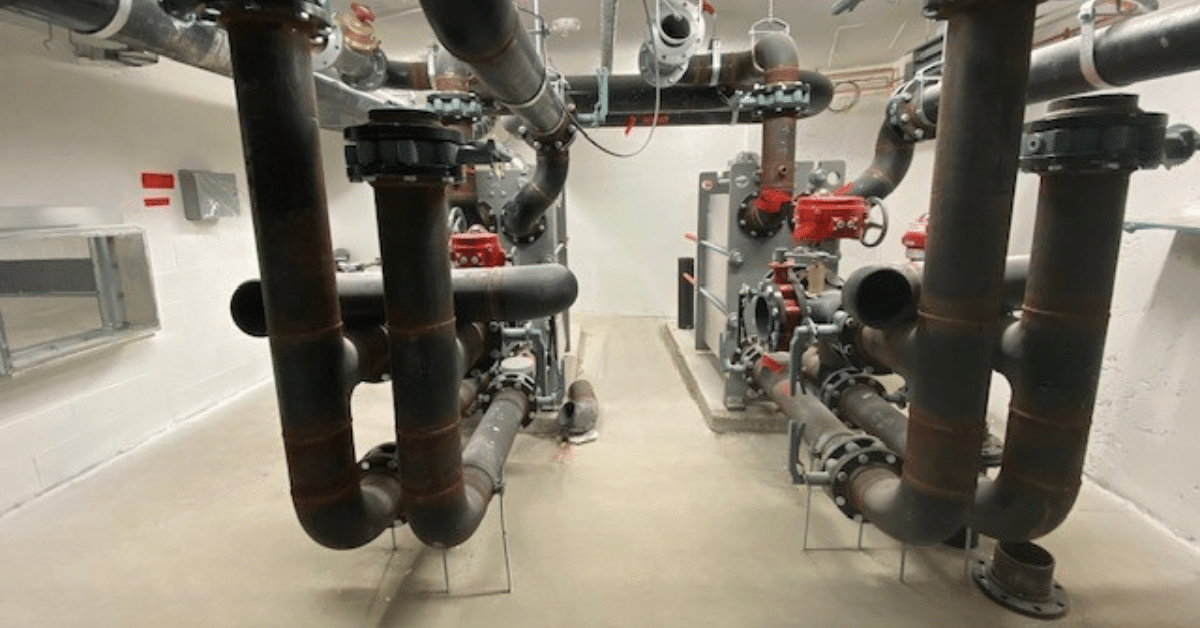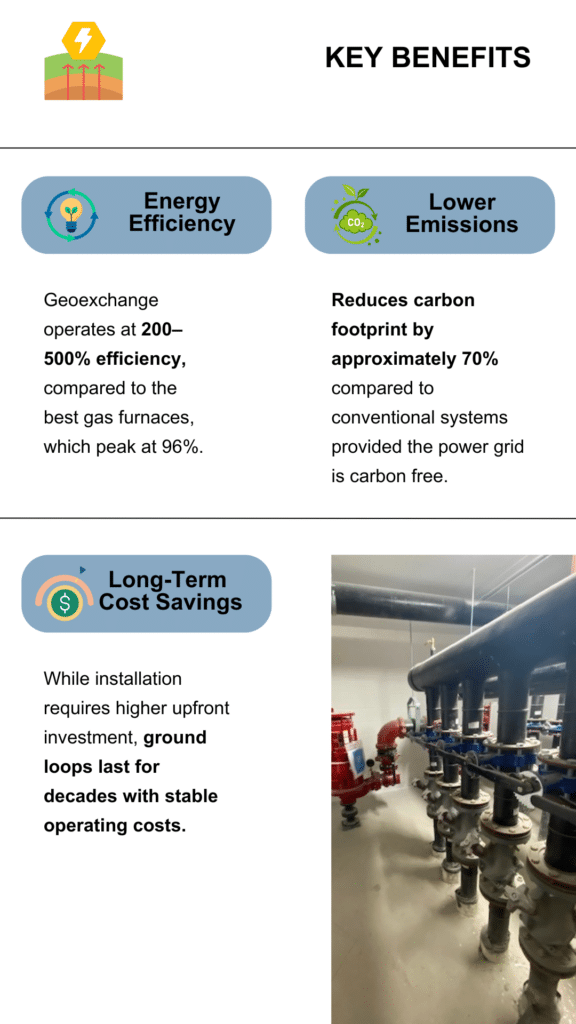Decarbonizing with Geoexchange in Canada’s Climate
Geoexchange isn’t just a standalone system; it’s a strategic tool for reducing energy costs and emissions. Whether driven by utility or carbon pricing, emissions targets, or ESG mandates, the shift toward net zero is already reshaping how buildings are designed, operated, and modernized worldwide.
In Canada’s climate, where temperatures can easily swing between +40°C and -40°C, many heating and cooling technologies struggle to maintain efficiency or become costly to operate. Geoexchange, when designed correctly, provides a stable and reliable long-term energy source maintained at a much tighter range throughout the year.

Capital cost considerations are often a key factor when discussing decarbonization options. Phased implementation can help balance upfront investments with long-term benefits. For example, a client may install a geoexchange system today while planning for future integration with solar PV and battery storage. Geo-exchange is a common way to electrify the heating being provided. How much this technology can decarbonize depends on how green the power grid serving the system is. If the power grid doesn’t come from low/no carbon sources, then there is simply a shift in the carbon emissions versus a reduction.
Geoexchange is fundamentally an electric heating solution. In provinces with low electricity costs (e.g., BC and Manitoba), adoption is more widespread. In Alberta, where natural gas is inexpensive, market adoption has been slower. However, geoexchange is becoming a more attractive solution for reducing operating costs.
Building envelope improvements also play a major role in optimizing geoexchange costs. A well-insulated building requires fewer boreholes, reducing drilling costs. In one of our projects, adding just 1–2 inches of extra insulation reduced borehole requirements by 30%, leading to significant savings.
How Geoexchange Works & Why It’s Effective
Geoexchange systems use ground-source heat pumps to extract and amplify stored thermal energy from the earth. Unlike traditional heating and cooling methods, which generate heat, geoexchange transfers it. This makes the system 2 to 5 times more efficient than conventional HVAC.

Even on the coldest days, the ground retains thermal energy. In summer, the system captures excess heat and stores it underground, creating a seasonal thermal battery that provides efficient heating in winter.
Geoexchange for New vs. Existing Buildings
Geoexchange is most effective when integrated into the early design phase. Optimized borefield placement ensures a higher return on investment, and systems can be paired with solar PV and battery storage for enhanced efficiency.
Retrofitting geoexchange comes with challenges, including space constraints, integration with legacy HVAC systems, and maintaining operations in occupied buildings. However, solutions exist:
- Modular systems & phased retrofits minimize disruption.
- Shared borefields offer a practical option for dense urban sites.
- Auxiliary systems (fluid coolers, boilers) help balance long-term system performance.
Geoexchange fields require ongoing monitoring to prevent overheating or depletion. Auxiliary systems play a crucial role in maintaining long-term efficiency by balancing heat injection and rejection throughout the year. If the system absorbs more heat in the winter than it can release in the summer—or vice versa—performance can decline, leading to inefficiencies or potential failure.
To sustain long-term performance, integrated solutions such as passive and active domestic water preheat systems or snowmelt systems can help regulate temperature balance. If additional heat exchange is needed, technologies like condensing or electric boilers, air-source heat pumps, or fluid coolers can be incorporated to stabilize the system. These measures ensure the geoexchange field remains efficient, reliable, and optimized for decades to come.
Closing Thoughts
Geoexchange is a valuable tool in the decarbonization toolkit when working on low/no-carbon electricity grids, offering long-term energy cost savings and emissions reductions. While not a one-size-fits-all solution, it is particularly well-suited for new builds and phased retrofits.
When paired with solar PV, auxiliary systems, and proper lifecycle management, geoexchange can be a game-changer for net-zero goals.
For organizations looking to reduce their carbon footprint, geoexchange offers a reliable, cost-effective solution that supports sustainable building performance.
Authors

Agustin
Olt
Partner, MCW Consultants

James Furlong
Executive Partner, MCW Consultants
Simplified Summary
Geoexchange is an energy-efficient way to heat and cool buildings. It helps lower costs and reduce emissions, making it a smart choice for Canada’s extreme climate. While the system costs more upfront, good planning can make it more affordable. This article explains how geoexchange works, its benefits, and why it’s a great option for greener buildings.
